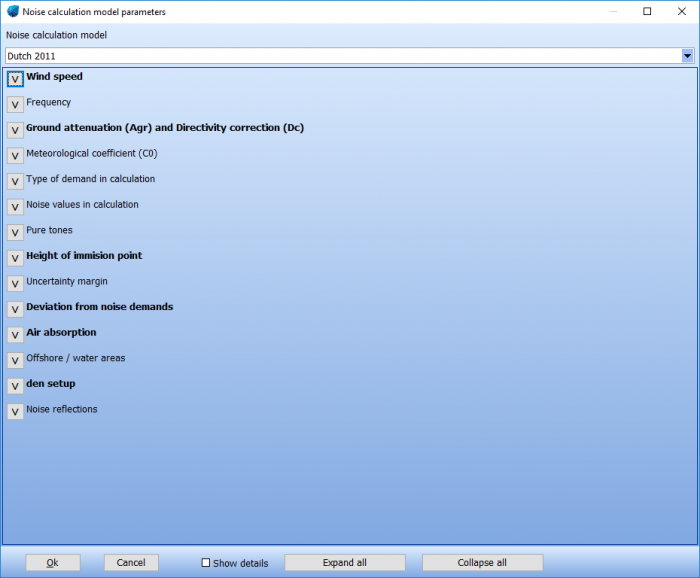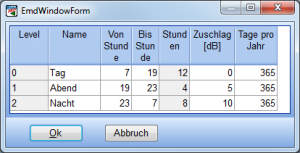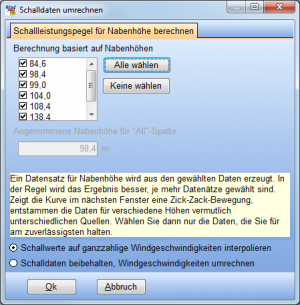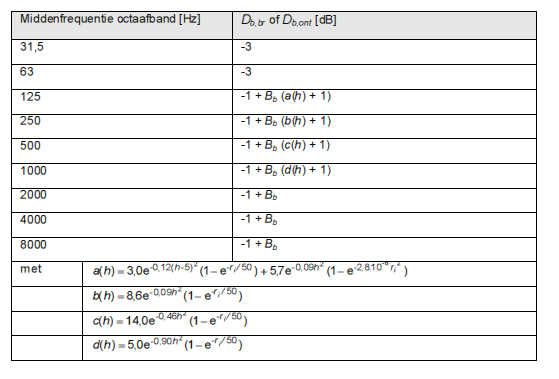Niederländische Vorschrift, 2011 (Englisch)
Zur deutschen Hauptseite | Alle deutschsprachigen Seiten
The Dutch calculation method[1] is based on the Lden principle and uses an adapted version of ISO 9613-2 as propagation model.
Calculation setup
The calculation model is selected by choosing Dutch 2011 as Noise calculation model.
Wind speed
The Dutch 2011 code operates with average noise received day, evening and night. In order to calculate how much noise on average is emitted in each time period, an average octave band distribution is calculated. This is based on the octave band distribution at each wind speed bin from cut in to cut out weighted with the frequency of that bin.
The octave band distributions for each wind speed bin must be found in the wind turbine catalogue. It goes without saying that it requires a fairly complete set of data, something which will rarely if ever be present among the default values in the catalogue. If only a limited amount of wind speeds are available windPRO will interpolate between them, set noise below cut-in to 3 m/s and set the noise constant when extrapolating from the highest wind speed to cut-out. If no octave band distribution exist for a specific wind speed windPRO will scale the octave band distribution of the closest wind speed. If no octave band distribution exists at all windPRO will fit a generic octave band distribution to the total noise level. This is of course insufficient for a correct calculation.
The frequency of each wind speed is found from a database provided by KNMI. In WindPRO is possible to choose the currently valid database from 2018 or the pre 2018 version. The 2018 version is documented here and provides wind distribution data in a dense (2.5km) grid across The Netherlands with data at 14 height levels from 10 m to 260 m. For hub heights in between the provided elevation levels an interpolation is made. Based on the location of the site center of the project windPRO looks up this location in the database and extract the frequency table for day, evening and night.
Note that because the Dutch method is linked to this database the Dutch method can only be used within the coverage of the database, meaning The Netherlands.
The formula for calculating the average noise for each time period is described in more detail in appendix.
Ground attenuation
The ground attenuation factor is defined for values of 0 and 1, but it is allowed to use any value in between. As default a terrain map can be used to calculate ground factor values, but alternatively a uniform value can be used.
Meteorological coefficient, C0
For distances less than 10 times hub height (actually 10 times difference in z coordinate of hub and receptor) the meteorological coefficient, C0 is 0. Beyond that distance C0 is a function of distance and direction from turbine to receptor in the way that maximum C0 is achieved downwind from the turbine.
The function for calculating C0 is described in appendix.
Type of demand in calculation
Only noise from WTG’s is taken into account.
Noise values in calculation
windPRO will on its own present all values as Lden values although sub-results present Lday, Levening and Lnight specifically.
Pure tones
Pure tone penalty are subtracted from demand.
Height of immission point above ground level
There is no mention in the code of receptor height. For the calculations it is set to 5 m.
Deviation from official noise demand
This field is open to the user.
Edit period
The Dutch codes operate with noise values as Lden, where den is an abbreviation of day-evening-night. It represents a weighted average of noise, where noise during evening and night is penalized. The parameters can be seen or modified by pressing the Edit period button as seen below.
The period definition of day, evening and night can be set here, as well as the penalty due for each period.
Noise receptors
The general noise limit in The Netherland is 47 dB Lden and 41 dB Lnight. The default setting for a Dutch receptor is 47 dB and this is also the noise value used on the noise ISO line report, but both Lden and Lnight can be found in the noise report.
Noise data for WTG
As described in a separate section below an individual noise mode can be selected for the three periods as part of advanced settings of the turbine.
Source noise data for the turbine is based on wind speed at hub height. If data for the turbine is only given at 10 m height they may need to be converted to hub height (section 2.6). Since a calculation is made for each integer wind speed at hub height it may be preferable to convert 10 m height wind speeds to hub height integer wind speed even though that means an interpolation of data points.
Weitere Themen
- DECIBEL-Überblick
- WEA-Schalldatenauswahl
- Bearbeiten von Schalldaten im WEA-Katalog
- Eingabe von Schall-Immissionsorten
- Eingaben für die DECIBEL-Berechnung
- DECIBEL-Ergebnisse
- Liste der Schallmodelle
Calculation Background
The Dutch codes require the calculation of an Lden value for each receptor.
The Lden value has the formula
The Leq noise value is calculated independently for the three situations: day, evening and night (Ldag, Lavond, Lnacht). In each case the formula is:
"I" is the 8 octave bands,
"n" is the number of turbines.
The noise at each octave band is calculated as:
Dref, Dscherm, Dveg and Dterrein can all be ignored.
LE
LE is the source noise emission. This is different from most other codes.
The LE is the average noise emission from the turbine. The formula is the below:
The summation is done for each wind speed bin from Vci (cut-in) to Vco (cut-out). At rated power it is assumed that the noise level does not change.
Uj is the frequency of the particular wind speed.
∆L is a direction component, which is usually not available and is therefore set to 0.
From this it is clear that a Weibull distribution is required at hub height for each turbine. This is done automatically with reference to http://www.mp.nl/rekentool/ . The codes recommend to use this resource however it only defines wind climate for height between 80 and 120 m. For heights outside this range windPRO fits the defined wind profile to a logarithmic function to extrapolate the Weibull distributions to higher and lower heights.
Dgeo
This is the geometric damping. It is identical to the ISO 9613-2 standard.
"r" is distance from turbine to receptor.
Dlucht
This is the air absorption. The formula is the same as in ISO 9613-2 but the damping’s are different.
Dbodem
This is the ground absorption. This is similar to the general ground attenuation of the ISO standard.
The regions are defined in the same way:
Near area:
Remote area:
Middle area:
Everything in between.
B is the ground porosity: B=1 absorbing, B=0 hard.
In windPRO it is possible to use a universal ground porosity is selected by the user to cover all three regions for all turbine receptor couples or link to an area object defining areas with ground porosity 0 assuming everything else is 1.
The three components are added:
Unfortunately the damping in each frequency is different from ISO 9613-2.
h is hub height.
The Dmid is calculated as
Cmeteo
Cmet is defined as
hb is hub height, ho is receptor height.
Beta is the angle from downwind from turbine to receptor.
References:
- ↑ Reken- en meetvoorschrift windturbines, 2/2-2010
Weitere Themen












